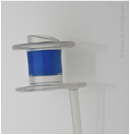Voice Prostheses during Radiation
Although many patients are worried about the effects of radiation to their voice prosthesis, but radiation will not harm the voice prosthesis in any way. Many patients find it too painful to speak during the later stages of radiation. Although the voice prosthesis may not be used for speaking, it is important to continue cleaning it as you normally would. See Cleaning Your Voice Prosthesis.
If, however, you have some question regarding the status of your voice prosthesis, the SLP staff will be able to examine this for you.
HME Use During Radiation Treatment
Regular use of an HME is very important to achieve the maximum benefit from the device. This is especially true during radiation when there can be some changes to the tracheal lining causing it to bleed easily with any crusting. There can also be changes to the thickness of the mucous you are producing and the HME will help to ensure your secretions are more manageable. For this reason, you should continue to wear your HME at all times, most especially during radiation.
Although it is important to continue wearing your HME, wearing an adhesive housing is not recommended during radiation. Since it is important to continue wearing the HME cassette, the SLP staff will assist you in finding the best alternate method for housing your HME cassette. Usually, you will be provided with a Larytube for this purpose. Like the other devices, the Larytube is not impacted by the radiation. It can also serve to provide support to the stoma during treatment and recovery, when the tissues can become very irritated and swollen. The SLP staff can advise you more in this regard.


